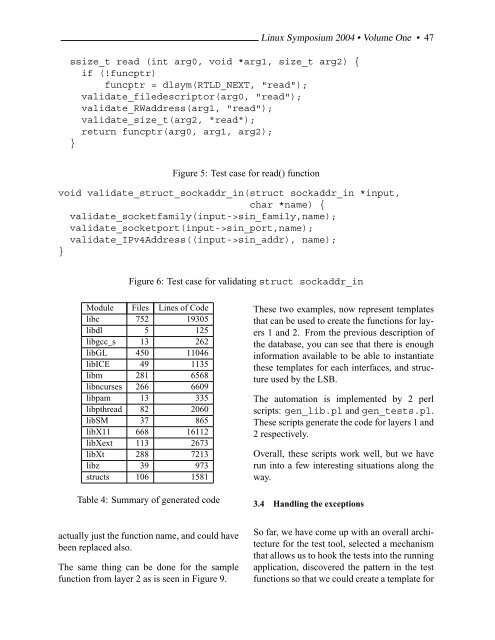You also want an ePaper? Increase the reach of your titles
YUMPU automatically turns print PDFs into web optimized ePapers that Google loves.
<strong>Linux</strong> Symposium 2004 • Volume <strong>One</strong> • 47<br />
ssize_t read (int arg0, void *arg1, size_t arg2) {<br />
if (!funcptr)<br />
funcptr = dlsym(RTLD_NEXT, "read");<br />
validate_filedescriptor(arg0, "read");<br />
validate_RWaddress(arg1, "read");<br />
validate_size_t(arg2, "read");<br />
return funcptr(arg0, arg1, arg2);<br />
}<br />
Figure 5: Test case for read() function<br />
void validate_struct_sockaddr_in(struct sockaddr_in *input,<br />
char *name) {<br />
validate_socketfamily(input->sin_family,name);<br />
validate_socketport(input->sin_port,name);<br />
validate_IPv4Address((input->sin_addr), name);<br />
}<br />
Figure 6: Test case for validating struct sockaddr_in<br />
Module Files Lines of Code<br />
libc 752 19305<br />
libdl 5 125<br />
libgcc_s 13 262<br />
libGL 450 11046<br />
libICE 49 1135<br />
libm 281 6568<br />
libncurses 266 6609<br />
libpam 13 335<br />
libpthread 82 2060<br />
libSM 37 865<br />
libX11 668 16112<br />
libXext 113 2673<br />
libXt 288 7213<br />
libz 39 973<br />
structs 106 1581<br />
Table 4: Summary of generated code<br />
<strong>The</strong>se two examples, now represent templates<br />
that can be used to create the functions for layers<br />
1 and 2. From the previous description of<br />
the database, you can see that there is enough<br />
information available to be able to instantiate<br />
these templates for each interfaces, and structure<br />
used by the LSB.<br />
<strong>The</strong> automation is implemented by 2 perl<br />
scripts: gen_lib.pl and gen_tests.pl.<br />
<strong>The</strong>se scripts generate the code for layers 1 and<br />
2 respectively.<br />
Overall, these scripts work well, but we have<br />
run into a few interesting situations along the<br />
way.<br />
3.4 Handling the exceptions<br />
actually just the function name, and could have<br />
been replaced also.<br />
<strong>The</strong> same thing can be done for the sample<br />
function from layer 2 as is seen in Figure 9.<br />
So far, we have come up with an overall architecture<br />
for the test tool, selected a mechanism<br />
that allows us to hook the tests into the running<br />
application, discovered the pattern in the test<br />
functions so that we could create a template for

















